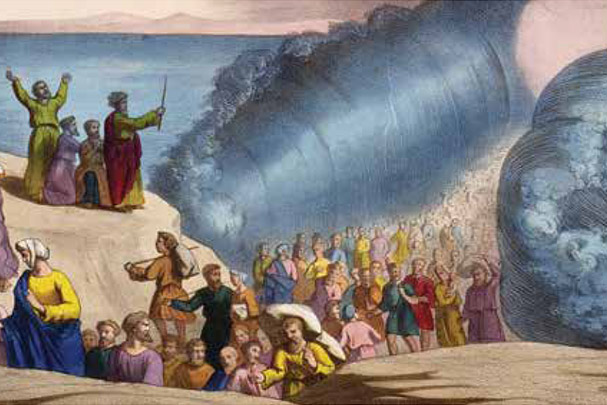This article first appeared in the Practical Hermeneutics column of the CHRISTIAN RESEARCH JOURNAL, volume 39, number 02 (2016). The full text of this article in PDF format can be obtained by clicking here. For further information or to subscribe to the CHRISTIAN RESEARCH JOURNAL go to: http://www.equip.org/christian-research-journal/
Why would anyone ask how to read historical narrative? How often do people who like to read biographies or history seek an answer to that question before they pick up a book? The question of reading historical narrative is with us for at least two reasons. One, for the past several centuries, it has been fashionable to deny what histories report. Two, much harm has been done by selective use of history or the abuse of history by misapplication. The simple answer to the question before us is to read historical narrative as it was intended to be read, as it presents itself, and as other witnesses corroborate. What does this mean?
Much of the Bible requires little or no interpretation, especially when it comes to historical narrative in contrast with parables, for example. God created the universe by His Word in six days; Noah built an ark and lived on it during the flood; Moses led the children of Israel out of Egypt; David escaped from Saul; Jesus taught and healed; Paul was shipwrecked. What happened is clear. How that applies to any given reader or what is supposed to happen when we read it is a different question. The Bible instructs on how to read historical narrative in several places. In Galatians 4, Paul explains how the history of Abraham and his family is indicative of any person’s experience as a sinner under the law or as redeemed by Christ. Jesus refers to the creation narrative of Adam and Eve in his response to the Pharisee’s challenge about divorce in Matthew 10. Peter explains baptism on the basis of Noah and the flood (1 Pet. 3:21). Paul notes twice that the history of Israel during the exodus was recorded as examples for us (1 Cor. 10:6, 11). The regular and clear references of biblical teaching to biblical history are our best means of knowing how to read historical narrative.
What Is Its Purpose? Practically speaking, we begin our reading of historical narrative with the perception that all history is written with a purpose and a perspective. “History is written by the victorious” is a well-known saying that is often, but not always, true. The history recorded in Samuel and Kings is predominantly negative because it is explaining why Israel is in exile. The history in Chronicles is mostly positive because it means to inspire the returning exiles to faithfulness. Often (if not always) the purpose of historical narrative is explicit and imbedded in the text. Within the narrative of Elijah and the prophets of Baal, we hear Elijah ask the people how long they intend to limp along between two opinions. The purpose of what took place is the same as the purpose of recording it for future generations; to demonstrate empirically who is the one and only true God. If explicit instruction on reading historical narrative is absent in the text, biblical history is still generally clear to the reader because it concerns what is universal and essential in human experience.
Life and death, waking and sleeping, war and peace, threats and defense, water, stone, animals, and food are the content of the biblical text because essentials of human existence are also universal. Even if we are engaging the historical narrative from a great distance in time and location, we still make sense of what the narrative reports. We have some idea of what a fortress is, even if we have never visited one. We have instincts regarding the relationship between shepherds and sheep and predators, even if we have lived in the city all our lives.
I had a mental picture of the logistics of David’s encounter with Goliath decades before I actually visited that valley or selected five smooth stones from the brook nearby. My mental picture was not essentially mistaken. A child may know nothing about leprosy but will correctly gather from the text that it is a miserable, contagious illness. We might not be surprised that the God who intended to reveal Himself to His creation would do so in ways that would be clear to readers of all times and places. Historical narrative does this well because the lives of the people in those narratives are parallel to our lives and experiences. History repeats itself because the essentials of human life are universal. As Ecclesiastes testifies over and over again, “There is nothing new under the sun” (Eccl. 1:9).
Take It at Its Word: Three Principles. The first principle for reading any text is to read it as it presents itself. Historical narrative is relatively easy to identify by its content and introduction. Historical narrative usually begins with placing it in time and place, noting key historical figures and locations in contrast with the ambiguity of fiction or fairy tale (“once upon a time” or “long ago and far away”). We all bring certain biases, preferences, and blind spots with us when we read, but the prejudices of modern arrogant skepticism need not be among them. In view of the surprising inventions and accomplishments of humanity over time, why would we be dismissive of reports that God and His servants do extraordinary things? If there is a God and He creates, then why can’t He create as quickly (or slowly) as He chooses? What explanation is there for the healing of wounds we experience except that God designed us to heal and wills us to; and if that is so, why couldn’t Jesus heal everyone, instantly, and from any distance?
In the recent past, the trend has been to dismiss all ancient historical narrative as fictional automatically. Then a man named Schliemann dug a trench on the Aegean coast of Turkey and discovered the remains of Troy. Joshua’s account of the conquest of Jericho was dismissed by modern critical scholars until archeologists found the remains of the walls of Jericho resting outside rather than inside their foundations. The book of Jonah gives no hint of being anything but literal history—and why not? On the other hand, consider how ineffective a fictional story would be for motivating Israel to repentance and faithfulness.
The second principle is to let the text interpret itself, beginning with the nearest context and then expanding to include the entire Bible. Besides grammars and lexicons, the Bible itself offers definitions for the language it uses—though in historical narrative, grammar and vocabulary are less of a challenge than in doctrinal discourse. If we are uncertain of particular terms or vocabulary, biblical texts can be identified that clarify.
For example, what exactly will the woman’s desire for her husband be, as recorded in Genesis 3:16? That word only occurs three times in the Bible, but one of those is in the very next chapter. In Genesis 4:7, the Lord warns that sin’s desire is for Cain, revealing that “desire” has to do with control. If a particular historical narrative is unclear to us, there are clear texts elsewhere in the Bible that will provide understanding. We seek clear texts in order to understand difficult texts.
The historical events of Naaman the Syrian or the widow of Zarephath are simple. The significance and import of those narratives are provided by Jesus Himself within the historical narrative of Jesus’ early teaching in the synagogue (Luke 4). If we are clear about what the historical narrative is reporting, we might find comment within that narrative that confirms the correct understanding of its content and intended application. Other biblical texts look forward to or back on the narrative, as the Old Testament looks forward to the promised Savior and the New Testament epistles look back to Him.
Parallels in history also provide perspective and clarity; consider the many feeding or healing or deliverance narratives throughout the Old and New Testaments. In addition to parallel narratives and comments imbedded in the narrative, the Bible provides doctrine based on historical narrative. Joseph explained to Pharaoh that his two dreams were to assure that the events prophesied in the dream would take place. Jesus and the New Testament writers constantly refer to historical narrative as historical, physical, factual experience that confirms doctrine just as the doctrine confirms the history (“If there is no resurrection of the dead, then Jesus didn’t rise” [1 Cor. 15]).
Third, reading historical narrative accurately depends on reading a lot of it—a lot of the time. The more we read, the more we notice patterns and the intent of those patterns. The Bible regularly begins a narrative with an overview of what took place, followed by a closer look at the most important part of that history. We see this in Genesis 2’s closer look at day six, which was recorded as part of the entire creation narrative in Genesis 1.
Genealogies begin with the least important people, moving steadily toward the generation of individuals of particular importance, such as Abraham and David. The general history of humanity is seen in bolder relief in the history of Israel and with greater specificity still in the lives of individuals, such as Jonah, who is indicative of Israel in particular and fallen human nature in general. Heroes of historical narrative point forward to the person and work of Christ even as the failures of those heroes point to the need for Christ.
Familiarity with the history of the judges and kings of Israel reveal an important pattern. Some kings are better and some are worse, but over the course of time, we see these human dynasties, like humanity itself, spiraling downward toward utter ruin. Noticing this descent of humanity makes the reader more attentive to, and aware of, the activity and promises of God, who consistently rescues us from ourselves. —Michael Eschelbach
Michael Eschelbach (MDiv, Concordia Theological Seminary; PhD in hermeneutics, Westminster Theological Seminary, Philadelphia) is a professor at Concordia University, Irvine, California. He was also a parish pastor for fifteen years in Montana and Michigan and is the author of several books.









